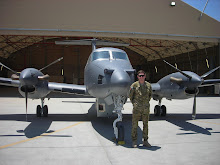 This is right after they landed on the pallet. The guy running is Ocasio - they came to a hover and threw a mic cord out so he could plug in and talk the pilots down. The trick is to get it centered on the pallet. The aircraft is stable with the rotors turning at 100% but the concern is that when the engines are shut down and the rotors slow the aircraft can start rocking if it isn't centered. It shook a little on shut down but overall it went really smooth.
This is right after they landed on the pallet. The guy running is Ocasio - they came to a hover and threw a mic cord out so he could plug in and talk the pilots down. The trick is to get it centered on the pallet. The aircraft is stable with the rotors turning at 100% but the concern is that when the engines are shut down and the rotors slow the aircraft can start rocking if it isn't centered. It shook a little on shut down but overall it went really smooth.
Monday, April 28, 2008
 This is right after they landed on the pallet. The guy running is Ocasio - they came to a hover and threw a mic cord out so he could plug in and talk the pilots down. The trick is to get it centered on the pallet. The aircraft is stable with the rotors turning at 100% but the concern is that when the engines are shut down and the rotors slow the aircraft can start rocking if it isn't centered. It shook a little on shut down but overall it went really smooth.
This is right after they landed on the pallet. The guy running is Ocasio - they came to a hover and threw a mic cord out so he could plug in and talk the pilots down. The trick is to get it centered on the pallet. The aircraft is stable with the rotors turning at 100% but the concern is that when the engines are shut down and the rotors slow the aircraft can start rocking if it isn't centered. It shook a little on shut down but overall it went really smooth.
Subscribe to:
Post Comments (Atom)

2 comments:
Several questions: Is the problem with landing on the pallets the smallness of the pallets? Do you have any visiblity directly underneath? How much space does a CH-47 need to land safely? (Without damage) Aren't there times when a pilot would have to land in a relatively small space without someone on the ground to guide? Or are Chinooks like battleships? Not suitable for stream navagation. (: If there isn't a lot of space, you just don't go there? What would the guy on the ground say? "A little to the left...No, not THAT left...the other left!!" Or is the language more technical?
Good questions Mom - I will try to answer them. That is the problem with the pallets - they are smaller than the aircraft so you have to be centered to reduce lateral rocking as the blades coast down on shutdown. The way we normally fly there is no visibility directly underneath. The crew members in the back can look straight down but not underneath the aircraft. That usually isn't a problem because we can see what is on the ground on the approach and if there is something there we don't land on it except this time the goal was to land on it. I have landed in some very small places with the rotor blades nicking the surrounding trees. So in theory if the area is greater than the rotor diameter then you can land there but just about the worst thing you can do with a helicopter is contact something with the blades. Plus, due to all the wind we create there has to be a very good reason to land in a small area and we have to take into account all the environmental factors (night, dust, snow ect). So normally it doesn't help us having someone on the ground - the guys on board can see everything they need to. If they do need to look directly underneath (like when hooking up a sling load) they can lift a hatch in the center of the floor and lean out to call us in. The language isn't technical but how we use it is. For example left and right are always based on the pilot's left and right or you could say looking from the rear of the aircraft to the front. So the crew members leaning down in the hole sometimes have to reverse it in their minds if they are looking to the rear. Hope this answers them all.
Post a Comment